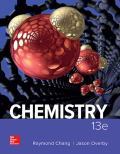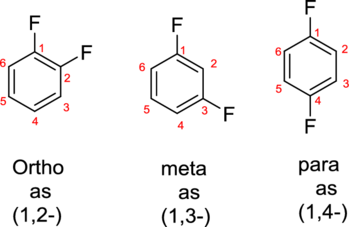
Chemistry
13th Edition
ISBN: 9781260162370
Author: Chang
Publisher: MCG
expand_more
expand_more
format_list_bulleted
Concept explainers
Question
Chapter 24, Problem 24.31QP
a)
Interpretation Introduction
Interpretation:
The structure for 1-bromo-3-methylbenzene has to be drawn.
Concept introduction:
- The parent compound of aromatic compound is Benzene.
- The substituent groups attached to the parent is identified. A substituent group contains group of atoms attached to the carbon atom of the aromatic ring.
- While numbering the parent, the location of the second group relative to the first substituent uses prefixes like o-ortho (1,2-), m-meta (1,3-), and p-para (1,4) in disubstituted aromatic ring.

b)
Interpretation Introduction
Interpretation:
The structure for 1-chloro-2-propyl-benzene has to be drawn.
Concept introduction:
Refer part ‘a’
c)
Interpretation Introduction
Interpretation:
The structure for 1,2,4,5-tetramethylbenzene has to be drawn.
Concept introduction:
Refer part ‘a’
Expert Solution & Answer
Want to see the full answer?
Check out a sample textbook solution
Students have asked these similar questions
Draw the structure of the pound in the provided
CO
as a 300-1200
37(2), 11 ( 110, and 2.5 (20
Please help me with # 4 and 5. Thanks in advance!
A small artisanal cheesemaker is testing the acidity of their milk
before it coagulates. During fermentation, bacteria produce lactic
acid (K₁ = 1.4 x 104), a weak acid that helps to curdle the milk and
develop flavor. The cheesemaker has measured that the developing
mixture contains lactic acid at an initial concentration of 0.025 M.
Your task is to calculate the pH of this mixture and determine whether
it meets the required acidity for proper cheese development. To
achieve the best flavor, texture and reduce/control microbial growth,
the pH range needs to be between pH 4.6 and 5.0.
Assumptions:
Lactic acid is a monoprotic acid
H
H
:0:0:
H-C-C
H
:0:
O-H
Figure 1: Lewis Structure for Lactic Acid
For simplicity, you can use the generic formula HA to represent the acid
You can assume lactic acid dissociation is in water as milk is mostly water.
Temperature is 25°C
1. Write the K, expression for the dissociation of lactic acid in the space provided. Do not forget to
include state symbols.…
Chapter 24 Solutions
Chemistry
Ch. 24.2 - How many structural isomers are there in the...Ch. 24.2 - Prob. 2PECh. 24.2 - Prob. 3PECh. 24.2 - Prob. 4PECh. 24.2 - Prob. 1RCFCh. 24.2 - For which of the following compounds are cis-trans...Ch. 24.3 - Prob. 1RCFCh. 24.4 - Prob. 5PECh. 24.4 - Prob. 1RCFCh. 24 - Prob. 24.1QP
Ch. 24 - Prob. 24.2QPCh. 24 - What do saturated and unsaturated mean when...Ch. 24 - Prob. 24.4QPCh. 24 - Prob. 24.5QPCh. 24 - Why is it that alkanes and alkynes, unlike...Ch. 24 - Prob. 24.7QPCh. 24 - Prob. 24.8QPCh. 24 - Prob. 24.9QPCh. 24 - Give examples of a chiral substituted alkane and...Ch. 24 - Draw all possible structural isomers for the...Ch. 24 - Prob. 24.12QPCh. 24 - Draw all possible isomers for the molecule C4H8.Ch. 24 - Draw all possible isomers for the molecule C3H5Br.Ch. 24 - Prob. 24.15QPCh. 24 - Prob. 24.16QPCh. 24 - Draw the structures of cis-2-butene and...Ch. 24 - Prob. 24.18QPCh. 24 - Prob. 24.19QPCh. 24 - Prob. 24.20QPCh. 24 - Prob. 24.21QPCh. 24 - Prob. 24.22QPCh. 24 - Prob. 24.23QPCh. 24 - Prob. 24.24QPCh. 24 - Which of the following amino acids are chiral: (a)...Ch. 24 - Name the following compounds: (a) CH3CCCH2CH3Ch. 24 - Prob. 24.27QPCh. 24 - Prob. 24.28QPCh. 24 - Prob. 24.29QPCh. 24 - Prob. 24.30QPCh. 24 - Prob. 24.31QPCh. 24 - Name the following compounds:Ch. 24 - Prob. 24.33QPCh. 24 - Prob. 24.34QPCh. 24 - Prob. 24.35QPCh. 24 - Prob. 24.36QPCh. 24 - Prob. 24.37QPCh. 24 - Prob. 24.38QPCh. 24 - Prob. 24.39QPCh. 24 - Prob. 24.40QPCh. 24 - Predict the product or products of each of the...Ch. 24 - Prob. 24.42QPCh. 24 - Prob. 24.43QPCh. 24 - Given these data...Ch. 24 - Prob. 24.45QPCh. 24 - Prob. 24.46QPCh. 24 - Prob. 24.47QPCh. 24 - Prob. 24.48QPCh. 24 - How many liters of air (78 percent N2, 22 percent...Ch. 24 - Prob. 24.50QPCh. 24 - Prob. 24.51QPCh. 24 - Prob. 24.52QPCh. 24 - Prob. 24.53QPCh. 24 - The combustion of 3.795 mg of liquid B, which...Ch. 24 - Prob. 24.55QPCh. 24 - Indicate the asymmetric carbon atoms in the...Ch. 24 - Prob. 24.57QPCh. 24 - Prob. 24.58QPCh. 24 - Prob. 24.59QPCh. 24 - Name the classes to which the following compounds...Ch. 24 - Prob. 24.61QPCh. 24 - Prob. 24.62QPCh. 24 - Prob. 24.63QPCh. 24 - Prob. 24.64QPCh. 24 - Prob. 24.65QPCh. 24 - Prob. 24.66QPCh. 24 - Prob. 24.67QPCh. 24 - When a mixture of methane and bromine vapor is...Ch. 24 - Prob. 24.69QPCh. 24 - Prob. 24.70QPCh. 24 - Prob. 24.71QPCh. 24 - Prob. 24.72QPCh. 24 - Prob. 24.73QPCh. 24 - Prob. 24.74QP
Knowledge Booster
Learn more about
Need a deep-dive on the concept behind this application? Look no further. Learn more about this topic, chemistry and related others by exploring similar questions and additional content below.Similar questions
- Curved arrows are used to illustrate the flow of electrons. Using the provided starting and product structures, draw the curved electron-pushing arrows for the following reaction or mechanistic step(s). Be sure to account for all bond-breaking and bond-making steps. :0: :0 H. 0:0 :0: :6: S: :0: Select to Edit Arrows ::0 Select to Edit Arrows H :0: H :CI: Rotation Select to Edit Arrows H. < :0: :0: :0: S:arrow_forward3:48 PM Fri Apr 4 K Problem 4 of 10 Submit Curved arrows are used to illustrate the flow of electrons. Using the provided starting and product structures, draw the curved electron-pushing arrows for the following reaction or mechanistic step(s). Be sure to account for all bond-breaking and bond-making steps. Mg. :0: Select to Add Arrows :0: :Br: Mg :0: :0: Select to Add Arrows Mg. Br: :0: 0:0- Br -190 H 0:0 Select to Add Arrows Select to Add Arrows neutralizing workup H CH3arrow_forwardIarrow_forward
- Draw the Markovnikov product of the hydrobromination of this alkene. Note for advanced students: draw only one product, and don't worry about showing any stereochemistry. Drawing dash and wedge bonds has been disabled for this problem. + Explanation Check 1 X E 4 1 1 1 1 1 HBr Click and drag to start drawing a structure. 80 LE #3 @ 2 $4 0 I அ2 % 85 F * K M ? BH 2025 McGraw Hill LLC. All Rights Reserved. Terms of Use Privacy Center & 6 27 FG F10 8 9 R T Y U D F G H P J K L Z X C V B N M Q W A S H option command H command optiarrow_forwardBe sure to use wedge and dash bonds to show the stereochemistry of the products when it's important, for example to distinguish between two different major products. Predict the major products of the following reaction. Explanation Q F1 A Check F2 @ 2 # 3 + X 80 F3 W E S D $ 4 I O H. H₂ 2 R Pt % 05 LL ee F6 F5 T <6 G Click and drag to start drawing a structure. 27 & A 2025 McGraw Hill LLC. All Rights Reserved. Terms of Use Privacy Center Acce Y U H DII 8 9 F10 4 J K L Z X C V B N M T H option command F11 P H commandarrow_forwardCurved arrows are used to illustrate the flow of electrons. Use the reaction conditions provided and follow the arrows to draw the intermediate and product in this reaction or mechanistic step(s). Include all lone pairs and charges as appropriate. Ignore stereochemistry. Ignore inorganic byproducts. H :0: CH3 O: OH Q CH3OH2+ Draw Intermediate protonation CH3OH CH3OH nucleophilic addition H Draw Intermediate deprotonation :0: H3C CH3OH2* protonation H 0: H CH3 H.arrow_forward
- Predicting the reactants or products of hemiacetal and acetal formation uentify the missing organic reactants in the following reaction: H+ X+Y OH H+ за Note: This chemical equation only focuses on the important organic molecules in the reaction. Additional inorganic or small-molecule reactants or products (like H2O) are not shown. In the drawing area below, draw the skeletal ("line") structures of the missing organic reactants X and Y. You may draw the structures in any arrangement that you like, so long as they aren't touching. Explanation Check Click and drag to start drawing a structure. ? olo 18 Ar © 2025 McGraw Hill LLC. All Rights Reserved. Terms of Use | Privacy Center | Accessibilityarrow_forwardcan someone please answer thisarrow_forwardPlease, please help me figure out the the moles, molarity and Ksp column. Step by step details because I've came up with about three different number and have no idea what I'm doing wrong.arrow_forward
arrow_back_ios
SEE MORE QUESTIONS
arrow_forward_ios
Recommended textbooks for you
 Introductory Chemistry: An Active Learning Approa...ChemistryISBN:9781305079250Author:Mark S. Cracolice, Ed PetersPublisher:Cengage Learning
Introductory Chemistry: An Active Learning Approa...ChemistryISBN:9781305079250Author:Mark S. Cracolice, Ed PetersPublisher:Cengage Learning

Introductory Chemistry: An Active Learning Approa...
Chemistry
ISBN:9781305079250
Author:Mark S. Cracolice, Ed Peters
Publisher:Cengage Learning
